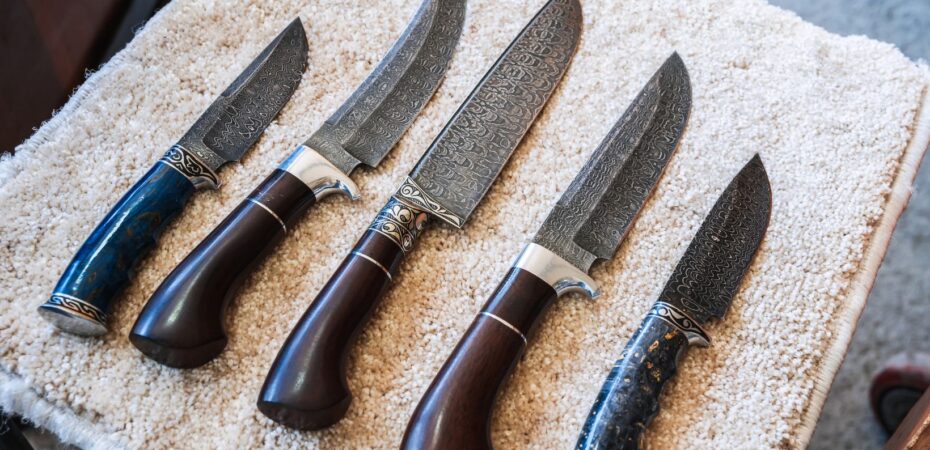Damascus steel is made by layering two or more types of steel, heating them, and hammering them together until they form a solid block. That block is folded, shaped, and etched to create a visible wave-like pattern on the blade. This process isn’t just about looks. It also improves the blade’s strength and edge retention.
The name “Damascus” comes from ancient trade routes, but today it usually means a modern version called pattern-welded steel. It’s made using known steel types like 1095 and 15N20 to control performance. This version of Damascus is more predictable and often stronger than historical blades.
Many people choose handmade Damascus knives because of the craftsmanship. Each one is made step by step by a skilled bladesmith. The result is a knife that’s sharp, balanced, and built to last.
What types of steel are used in Damascus blades?
Modern Damascus knives often use a mix of carbon steels. A popular combo is 1095 and 15N20. One turns dark during etching. The other stays bright. This contrast is what forms the pattern.
Some bladesmiths use stainless steel, but that’s harder to work with. It needs more heat and careful timing. Most smiths stick with carbon steel because it gives better control and performance.
The number of layers affects the pattern, not the cutting quality. You might see 100, 200, or even 300 layers. That doesn’t mean the blade is sharper. It just means the design will look more detailed.
How are handmade Damascus knives forged? Step-by-step

Making a Damascus knife by hand involves several key steps. Here’s how it works:
1. Stacking the steel
The smith cuts strips of two steels and stacks them. The starting number is usually between 10 and 20 layers.
2. Forge welding
The stack is heated to over 1200°C and covered with borax. This keeps air out. Then it’s hammered until the layers fuse.
3. Drawing out and folding
The billet (steel block) is stretched, folded, and hammered again. This adds more layers. Some smiths repeat the process several times.
4. Pattern creation
The smith twists, cuts, or grinds the billet to create the pattern. Styles include ladder, twist, raindrop, and feather.
5. Shaping the blade
The rough blade is ground to its final shape. This includes shaping the tip, bevels, and tang. It must feel balanced in the hand.
6. Heat treatment
The finished blade is hardened and then tempered. Most knives reach 58–62 on the Rockwell scale (HRC), which is ideal for daily use.
How is the pattern revealed?
Once the blade is heat-treated and polished, it goes into an acid bath. The acid reacts with each steel type differently. That’s what makes the lines and waves stand out.
After etching, the blade is cleaned and polished again. This final touch helps sharpen the pattern. Then the handle is attached.
Handles can be made of wood, bone, resin, or composite materials like micarta. A good handle should fit well in your hand and stay secure during use.
What makes handmade Damascus knives better than factory ones?
A handmade blade is crafted from raw steel with hands-on control at every step. The smith adjusts the heat, hammering, and grinding in real time. That gives better results.
In contrast, factory knives are often stamped out and finished by machine. Some have fake patterns that are just printed on the surface.
You can buy a factory knife for $50 to $150. Handmade ones often range from $200 to $800. The difference is in the materials, time, and experience.
What are the common myths about Damascus steel?
Let’s clear up a few false claims:
- “Damascus can cut a gun barrel.” This story goes back hundreds of years. It’s not true.
- “More layers make it sharper.” Layer count affects appearance, not sharpness.
- “Any patterned steel is Damascus.” Some knives use acid or laser to fake the look. Real Damascus has layers you can see and feel.
How can you tell if a Damascus knife is real?
Check the pattern closely. Real Damascus has designs on the spine and around the edges, not just the flat sides. You might feel a slight texture in the steel.
Ask the seller if it’s pattern-welded. Good makers often show photos or videos of their process. Look for signs of forging, not just surface etching.
If it looks too perfect, it might be a printed design. True Damascus has small flaws and natural variations in the pattern.
Final thoughts: What makes Damascus forging an art?
A Damascus knife is made through fire, pressure, and skill. It takes years to learn how to forge steel properly. Every cut, fold, and polish changes the final result.
That’s why handmade Damascus knives aren’t just tools. They’re the result of a maker’s time, effort, and hands-on care.


 By
By 



